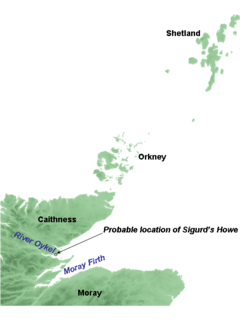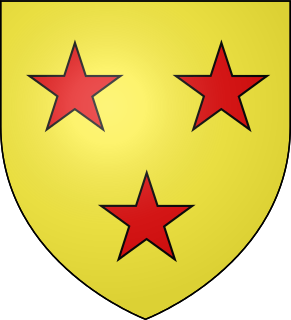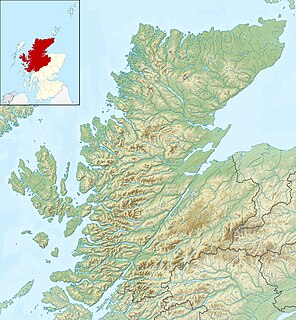
Dornoch is a town, seaside resort, parish and former royal burgh in the county of Sutherland in the Highlands of Scotland. It lies on the north shore of the Dornoch Firth, near to where it opens into the Moray Firth to the east.

Sutherland is a historic county, registration county and lieutenancy area in the Highlands of Scotland. Its county town is Dornoch. Sutherland borders Caithness and Moray Firth to the east, Ross-shire and Cromartyshire to the south and the Atlantic to the north and west. Like its southern neighbour Ross-shire, Sutherland has some of the most dramatic scenery in the whole of Europe, especially on its western fringe where the mountains meet the sea. These include high sea cliffs, and very old mountains composed of Precambrian and Cambrian rocks.

Halkirk is a village on the River Thurso in Caithness, in the Highland council area of Scotland. From Halkirk the B874 road runs towards Thurso in the north and towards Georgemas in the east. The village is within the parish of Halkirk, and is said by locals to be Scotland's first planned village.

Dornoch Cathedral is a former cathedral and is now a Church of Scotland parish church serving the small Sutherland town of Dornoch, in the Scottish Highlands. As a congregation of the Church of Scotland, which is Presbyterian, the church is not the seat of a bishop but retains the name due to being, historically, the seat of the Bishop of Caithness. The Cathedral's churchyard is adjoined by Dornoch Castle, the somewhat reconstructed remains of the medieval palace of the Bishops of Caithness.

Clan Sutherland is a Highland Scottish clan whose traditional territory is the shire of Sutherland in the far north of Scotland. The chief of the clan was also the powerful Earl of Sutherland, however in the early 16th century this title passed through marriage to a younger son of the chief of Clan Gordon. The current chief is Alistair Sutherland who holds the title Earl of Sutherland.

Rögnvald Kali Kolsson, also known as Saint Ronald of Orkney, was a Norwegian earl of Orkney who came to be regarded as a Christian saint. Two of the Orkneys are named after Rögnvald, namely North Ronaldsay and South Ronaldsay.

Harald Maddadsson was Earl of Orkney and Mormaer of Caithness from 1139 until 1206. He was the son of Matad, Mormaer of Atholl, and Margaret, daughter of Earl Haakon Paulsson of Orkney. Of mixed Norse and Gaelic blood, and a descendant of Scots kings, he was a significant figure in northern Scotland, and played a prominent part in Scottish politics of the twelfth century. The Orkneyinga Saga names him one of the three most powerful Earls of Orkney along with Sigurd Eysteinsson and Thorfinn Sigurdsson.

The Bishop of Caithness was the ecclesiastical head of the Diocese of Caithness, one of Scotland's 13 medieval bishoprics. The first referenced bishop of Caithness was Aindréas, a Gael who appears in sources between 1146 and 1151 as bishop. Aindréas spent much if not all of his career outside his see.

Sigurd Eysteinsson or Sigurd the Mighty was the second Earl of Orkney – a title bequeathed to Sigurd by his brother Rognvald Eysteinsson. A son of Eystein Glumra, Sigurd was a leader in the Viking conquest of what is now northern Scotland.
Jon Haraldsson was a Norwegian noble who served as the Jarl of Orkney between 1206 and 1231. Jon Haraldsson and his brother David were the sons of Harald Maddadsson with his second wife Hvarflod, daughter of Earl Máel Coluim of Moray. Jon and David were joint Earls of Orkney after the death of their father in 1206. David Haraldsson died of sickness in 1214, leaving Jon Haraldsson to rule alone. William the Lion, king of Scotland, took Jon's daughter hostage in August 1214 as part of a peace agreement with the new sole Earl.
Andreas or Aindréas of Caithness is the first known bishop of Caithness and a source for the author of de Situ Albanie. Aindréas was a native Scot, and very likely came from a prominent family in Gowrie, or somewhere in this part of Scotland. He was a prominent landowner in Gowrie, Angus and Fife, and it is likely that he was a brother of one Eòghan "of Monorgan", another Gowrie landlord. At some stage in his career, he was a monk of Dunfermline Abbey, though it is not known if this was before or during his period as bishop of Caithness.
Adam of Melrose was Abbot of Melrose and Bishop of Caithness, famously burned to death by the husbandmen of Caithness. At the time, Caithness was part of the Jarldom of Orkney, which formed part of the Kingdom of Norway.
Gilbert de Moravia, later known as Saint Gilbert of Dornoch, or Gilbert of Caithness, was the most famous Bishop of Caithness and founder of Dornoch Cathedral. His name may suggest that he came from the semi-Gaelicized family of Flemish origin who were Lords of Duffus, and who during Gilbert's episcopate would create the Earldom of Sutherland under Gilbert's possible cousin, William de Moravia, 1st Earl of Sutherland.

Inverness Cathedral, also known as the Cathedral Church of Saint Andrew (1866–69), is a cathedral of the Scottish Episcopal Church situated in the city of Inverness in Scotland close to the banks of the River Ness. It is the seat of the Bishop of Moray, Ross and Caithness, ordinary of the Diocese of Moray, Ross and Caithness. The cathedral is the northernmost cathedral in mainland Britain and was the first new Protestant cathedral to be completed in Great Britain since the Reformation.
Alan de St Edmund was a 13th-century English cleric and administrator of the Roman Catholic Church. His name suggests a connection with Bury St. Edmunds Abbey in Suffolk, but there is no direct evidence. He was the chaplain of Hugh of Evesham, another Englishman, from the diocese of Worcester, who in 1282 was made Presbyter-Cardinal of St Laurence in Lucina by Pope Martin IV. After Hervey de Dundee, bishop-elect of Caithness, died while seeking confirmation at the Roman curia, the pope chose Alan - still in Rome - for the bishopric. Alan was provided by Pope Martin on 13 April 1282.
Alexander Vaus [Vause, de Vaus] was a late 14th century and 15th century Scottish prelate. Said to have been the younger son of one Patrick Vaus, he apparently held "church livings" in Galloway as early as 1421.
Reinald Macer [also called Reginald] was a medieval Cistercian monk and bishop, active in the Kingdom of Scotland during the reign of William the Lion. Originally a monk of Melrose Abbey, he rose to become Bishop of Ross in 1195, and held this position until his death in 1213. He is given the nickname Macer in Roger of Howden's Chronica, a French word that meant "skinny".

The Battle of Skibo and Strathfleet was prompted by Clan Donald's invasion of the area around Dornoch in northern Scotland in 1480. Two attacks were repulsed by the local clans of Clan Sutherland and the Murrays of Aberscross.

The Battle of Torran-Roy was a Scottish clan battle that took place in the year 1570 in the county of Sutherland, Scotland. It was fought between the forces of Alexander Gordon, 12th Earl of Sutherland and the forces of George Sinclair, 4th Earl of Caithness. The Earl of Sutherland's force consisted primarily of the Murrays of Aberscross who despite their name were not part of the Clan Murray in Atholl, but who were a sept of the Clan Sutherland, and who as the principal vassals of the Earl of Sutherland, were charged with the defense of the shire. The Earl of Caithness's forces consisted primarily of followers of the Sutherland Laird of Duffus who was a descendant of the old de Moravia/Sutherland Earls of Sutherland who had been ousted and replaced by the Gordons as earls in the early 16th-century.

Scrabster Castle was a castle near the village of Scrabster, Highland in Scotland.












